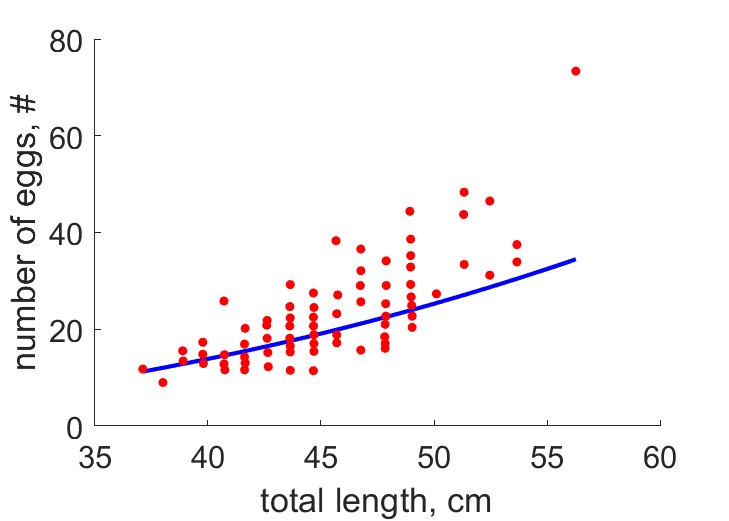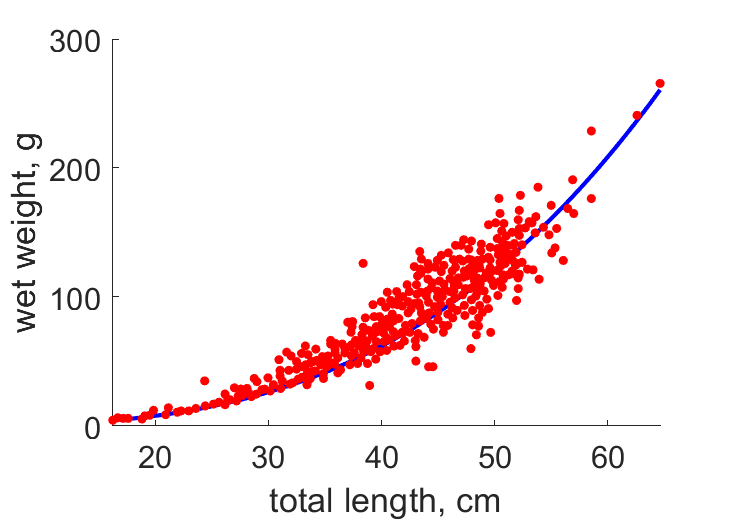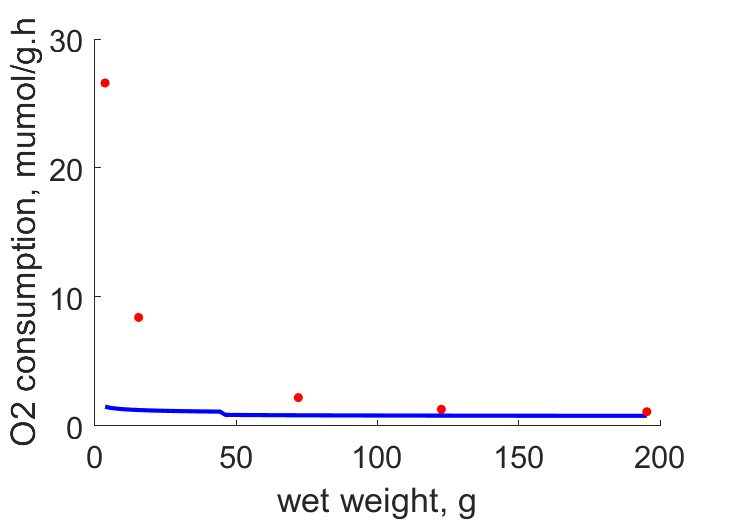Predictions & Data for this entry
| Model: std | climate: MC | migrate: | phylum: |
| COMPLETE = 1.7 | ecozone: MAN | food: biSvf | class: |
| MRE = 0.165 | habitat: 0iMd | gender: D | order: |
| SMSE = 0.385 | embryo: Ms | reprod: O | family: |
Zero-variate data
| Data | Observed | Predicted | (RE) | Unit | Description | Reference |
|---|---|---|---|---|---|---|
| am | 7300 | 7111 | (0.02588) | d | life span | guess |
| pX | 2353 | 2186 | (0.07093) | J/d | energy intake at 122.6 g | LessMart1996 |
| Lb | 9.8 | 10.2 | (0.04052) | cm | total length at birth | GranBish2009 |
| Lp | 34.3 | 36.22 | (0.05592) | cm | total length at puberty | GranBish2009 |
| Li | 65 | 60.08 | (0.0757) | cm | ultimate total length | Gran2006 |
| Wwb | 0.9 | 1.025 | (0.1386) | g | wet weight at birth | GranBish2009 |
| Wwp | 47 | 45.92 | (0.02306) | g | wet weight at puberty | GranBish2009 |
| Wwi | 275 | 209.6 | (0.2378) | g | ultimate wet weight | GranBish2009 |
| Ri | 0.1041 | 0.101 | (0.02965) | #/d | max reproduction rate | GranBish2009 |
Uni- and bivariate data
| Data | Figure | Independent variable | Dependent variable | (RE) | Reference |
|---|---|---|---|---|---|
| LN |  | total length | number of eggs | (0.2472) | GranBish2009 |
| LW |  | total length | wet weight | (0.1682) | Gran2006 |
| WO |  | wet weight | O2 consumption | (0.8714) | LessMart1996 |
Pseudo-data at Tref = 20°C
| Data | Generalised animal | Myxine glutinosa | Unit | Description |
|---|---|---|---|---|
| v | 0.02 | 0.09756 | cm/d | energy conductance |
| p_M | 18 | 80.34 | J/d.cm^3 | vol-spec som maint |
| k_J | 0.002 | 0.002 | 1/d | maturity maint rate coefficient |
| k | 0.3 | 0.11 | - | maintenance ratio |
| kap | 0.8 | 0.76 | - | allocation fraction to soma |
| kap_G | 0.8 | 0.805 | - | growth efficiency |
| kap_R | 0.95 | 0.95 | - | reproduction efficiency |
Discussion
- ASSUMPTION: reproduction is once per year
- The only measured rate in the data below is the respiration rate
- blood volume = 18% of total body weight, 3 times higher than other fish (LessMart96)
Facts
- No evidence of spawning or reprod-cycle synchronisation. Larger females do not produce larger eggs. Females are much more abundant (99:1), might be a result of catching method. Initially both male and female gonad develop, then one of them reduces. Hermaphrodites are rare (0.2-0.3 percent). Male and female mature at same size. Reduction in L_p, W_p with reduction in average ind in the pop (DEB interpretation is: k_J < k_M) (Ref: GranBish2009)
- "On the southwest slope of the Grand Bank, Atlantic hagfish are not captured in shallow sub-zero waters and appear to concentrate (greatest catches) within the warmest (5.8-9.0 C) available bottom waters which occur within depths of 125-400 m." (Ref: GranBish2009a)
- "There is no known method of aging hagfish however a recent review of conceptual models of hagfish fishery science and management suggested growth may approximate 20 mm/year" (Ref: MartGran2007)
Bibliography